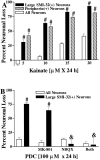Motor neurons are selectively vulnerable to AMPA/kainate receptor-mediated injury in vitro
- PMID: 8753869
- PMCID: PMC6578994
- DOI: 10.1523/JNEUROSCI.16-13-04069.1996
Motor neurons are selectively vulnerable to AMPA/kainate receptor-mediated injury in vitro
Abstract
The nonphosphorylated neurofilament marker SMI-32 stains motor neurons in spinal cord slices and stains a subset of cultured spinal neurons ["large SMI-32(+) neurons"], which have a morphology consistent with motor neurons identified in vitro: large cell body, long axon, and extensive dendritic arborization. They are found preferentially in ventral spinal cord cultures, providing further evidence that large SMI-32(+) neurons are indeed motor neurons, and SMI-32 staining often colocalizes with established motor neuron markers (including acetylcholine, calcitonin gene-related peptide, and peripherin). Additionally, choline acetyltransferase activity (a frequently used index of the motor neuron population) and peripherin(+) neurons share with large SMI-32(+) neurons an unusual vulnerability to AMPA/kainate receptor-mediated injury. Kainate-induced loss of these motor neuron markers is Ca2+-dependent, which supports a critical role of Ca2+ ions in this injury. Raising extracellular Ca2+ exacerbates injury, whereas removal of extracellular Ca2+ is protective. A basis for this vulnerability is provided by the observation that most peripherin(+) neurons, like large SMI-32(+) neurons, are subject to kainate-stimulated Co2+ uptake, a histochemical stain that identifies neurons possessing Ca2+-permeable AMPA/kainate receptor-gated channels. Finally, of possibly greater relevance to the slow motor neuronal degeneration in diseases, both large SMI-32(+) neurons and peripherin(+) neurons are selectively damaged by prolonged (24 hr) low-level exposures to kainate (10 microM) or to the glutamate reuptake blocker L-trans-pyrrolidine-2,4-dicarboxylic acid (100 microM). During these low-level kainate exposures, large SMI-32(+) neurons showed higher intracellular Ca2+ concentrations than most spinal neurons, suggesting that Ca2+ ions are also important in this more slowly evolving injury.
Figures







Similar articles
-
In vitro kainate injury to large, SMI-32(+) spinal neurons is Ca2+ dependent.Neuroreport. 1995 Apr 19;6(6):945-8. doi: 10.1097/00001756-199504190-00030. Neuroreport. 1995. PMID: 7612889
-
Ca2+ permeable AMPA/kainate channels permit rapid injurious Ca2+ entry.Neuroreport. 1995 May 30;6(8):1089-92. doi: 10.1097/00001756-199505300-00004. Neuroreport. 1995. PMID: 7545016
-
AMPA exposures induce mitochondrial Ca(2+) overload and ROS generation in spinal motor neurons in vitro.J Neurosci. 2000 Jan 1;20(1):240-50. doi: 10.1523/JNEUROSCI.20-01-00240.2000. J Neurosci. 2000. PMID: 10627601 Free PMC article.
-
AMPA/kainate receptor-mediated damage to NADPH-diaphorase-containing neurons is Ca2+ dependent.Neurosci Lett. 1994 Feb 14;167(1-2):93-6. doi: 10.1016/0304-3940(94)91035-9. Neurosci Lett. 1994. PMID: 7513843
-
Kainate-stimulated Zn2+ uptake labels cortical neurons with Ca2+-permeable AMPA/kainate channels.Brain Res. 1998 Jan 19;781(1-2):45-56. doi: 10.1016/s0006-8993(97)01208-0. Brain Res. 1998. PMID: 9507061
Cited by
-
Hippocampal glutamate level and glutamate aspartate transporter (GLAST) are up-regulated in senior rat associated with isoflurane-induced spatial learning/memory impairment.Neurochem Res. 2013 Jan;38(1):59-73. doi: 10.1007/s11064-012-0889-8. Epub 2012 Oct 16. Neurochem Res. 2013. PMID: 23070469
-
Disruption of glial glutamate transport by reactive oxygen species produced in motor neurons.J Neurosci. 2003 Apr 1;23(7):2627-33. doi: 10.1523/JNEUROSCI.23-07-02627.2003. J Neurosci. 2003. PMID: 12684448 Free PMC article.
-
Induced loss of ADAR2 engenders slow death of motor neurons from Q/R site-unedited GluR2.J Neurosci. 2010 Sep 8;30(36):11917-25. doi: 10.1523/JNEUROSCI.2021-10.2010. J Neurosci. 2010. PMID: 20826656 Free PMC article.
-
Membralin deficiency dysregulates astrocytic glutamate homeostasis leading to ALS-like impairment.J Clin Invest. 2019 May 21;129(8):3103-3120. doi: 10.1172/JCI127695. J Clin Invest. 2019. PMID: 31112137 Free PMC article.
-
Controlling the Regional Identity of hPSC-Derived Neurons to Uncover Neuronal Subtype Specificity of Neurological Disease Phenotypes.Stem Cell Reports. 2015 Dec 8;5(6):1010-1022. doi: 10.1016/j.stemcr.2015.10.005. Epub 2015 Nov 5. Stem Cell Reports. 2015. PMID: 26549851 Free PMC article.
References
-
- Ang LC, Bhaumich B, Munoz DG, Sass J, Juurlink BHJ. Effects of astrocytes, insulin and insulin-like growth factor 1 on the survival of motor neurons in vitro . J Neurol Sci. 1992;109:168–172. - PubMed
-
- Bochet P, Audinet E, Lambolez B, Crepel F, Rossier J, Iino M, Tsuzuki K, Ozawa S. Subunit composition at the single-cell level explains functional properties of a glutamate-gated channel. Neuron. 1994;12:383–388. - PubMed
-
- Brorson JR, Bleakman D, Chard PS, Miller RJ. Calcium directly permeates kainate/alpha-amino-3-hydroxy-5-methyl-4-isoxazoleproprionic acid receptors in cultured cerebellar Purkinje neurons. Mol Pharmacol. 1992;41:603–608. - PubMed
Publication types
MeSH terms
Substances
Grants and funding
LinkOut - more resources
Full Text Sources
Other Literature Sources
Miscellaneous
